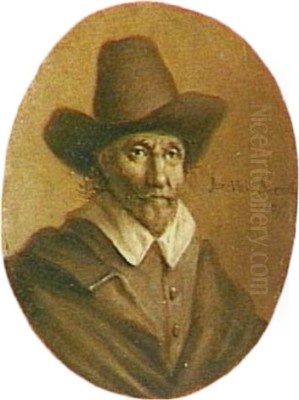
Emanuel de Witte (circa 1617–1692) stands as a prominent figure in the constellation of Dutch Golden Age painters, celebrated particularly for his evocative depictions of church interiors and bustling market scenes. His life, marked by both artistic innovation and personal tribulation, unfolded against the backdrop of a flourishing Dutch Republic, a period of extraordinary cultural and economic vibrancy. De Witte's unique ability to capture the interplay of light and shadow, to convey a profound sense of space, and to imbue his architectural subjects with an almost palpable atmosphere distinguishes him from many of his contemporaries. His work offers a window into the spiritual and secular life of 17th-century Holland, rendered with a sensitivity that continues to resonate with viewers today.
Early Life and Artistic Formation
Born in Alkmaar around 1617, Emanuel de Witte was the son of a schoolmaster, an upbringing that likely provided him with a solid education. Early records suggest a free-thinking disposition, a trait that perhaps influenced his later artistic choices and his often-unconventional life. His formal artistic training began in his hometown, and by 1636, he had joined the Guild of Saint Luke in Alkmaar, the professional organization for painters and other craftsmen. This membership marked his official entry into the world of professional art.
His early career saw him move between several Dutch cities, a common practice for artists seeking patronage and new influences. In 1639, he relocated to Rotterdam, and by 1641, he was living in Delft, a city that was then a vibrant center for artistic innovation. It was during his Delft period, which lasted until around 1650, that De Witte's artistic direction began to solidify. He is known to have studied with, or at least been significantly influenced by, the Delft still-life painter Evert van Aelst. While Van Aelst specialized in a different genre, the meticulous observation and rendering skills required for still life would have been valuable for any aspiring painter. During this phase, De Witte also explored religious and mythological themes, common subjects in the broader European artistic tradition.
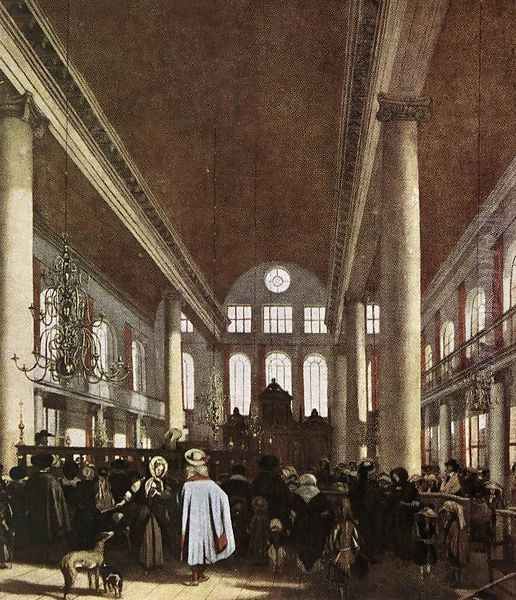
The artistic environment in Delft was particularly stimulating. The city was home to painters like Carel Fabritius, whose experiments with perspective and light were groundbreaking, and Johannes Vermeer, renowned for his luminous interior scenes. Though their primary subjects differed, the shared interest in capturing light and creating convincing spatial illusions was a hallmark of the Delft School. De Witte would have been exposed to these currents, which undoubtedly shaped his evolving approach to architectural painting.
The Amsterdam Years and Specialization
Around 1651 or 1652, Emanuel de Witte made his final significant move, settling in Amsterdam, the bustling commercial and cultural heart of the Dutch Republic. This city, with its newly built churches and vibrant public spaces, provided ample subject matter for his talents. It was in Amsterdam that De Witte truly came into his own as a painter of church interiors, the genre for which he is most celebrated. He became a leading figure in the late Baroque architectural painting school, developing a style that was both innovative and deeply personal.
His focus on church interiors was not merely a technical exercise in perspective, though his mastery of it was considerable. De Witte was interested in the atmosphere of these sacred spaces, the way light filtered through high windows, illuminating dust motes in the air and casting complex patterns of shadow across stone floors and wooden pews. He often included small figures in his compositions – worshippers, visitors, even dogs – which served not only to animate the scenes but also to emphasize the scale and grandeur of the architecture. These figures, often engaged in quiet activities, contribute to the sense of a living, breathing space rather than a static architectural model.
De Witte’s depictions of Amsterdam’s famous churches, such as the Oude Kerk (Old Church) and the Nieuwe Kerk (New Church), are among his most iconic works. He did not always aim for strict topographical accuracy, sometimes taking liberties with architectural details or combining elements from different buildings to achieve a desired compositional or atmospheric effect. This approach distinguished him from contemporaries like Pieter Jansz. Saenredam, whose church interiors were characterized by an almost scientific precision and a cool, clear light. De Witte, by contrast, sought a more subjective and emotive response, using light and shadow to evoke a sense of awe, reverence, or quiet contemplation.
Artistic Style and Signature Techniques
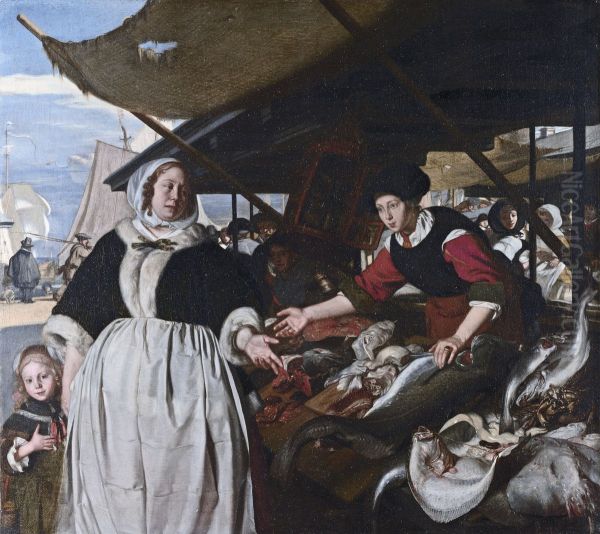
Emanuel de Witte's artistic style is characterized by several key elements that contribute to the power and distinctiveness of his work. His profound understanding of perspective was fundamental, allowing him to create convincing illusions of deep, receding spaces within his church interiors. He often employed a diagonal viewpoint, which added dynamism and complexity to his compositions, drawing the viewer's eye into the scene along converging lines.
Mastery of Light and Shadow (Chiaroscuro)
Perhaps De Witte's most celebrated skill was his handling of light and shadow. He was a master of chiaroscuro, using strong contrasts to model forms, define space, and create dramatic effects. Sunlight often streams into his churches from unseen windows, illuminating specific areas while leaving others in deep shadow. This selective illumination not only highlights architectural features but also creates a powerful mood, ranging from serene to mysterious. His ability to render the subtle gradations of light, the way it reflects off different surfaces – stone, wood, metal – was exceptional. This sensitivity to light was a shared characteristic of many Dutch Golden Age painters, including Rembrandt van Rijn and Johannes Vermeer, though each applied it to different ends.
Perspective and Spatial Composition
De Witte’s compositions are typically complex, featuring soaring columns, intricate vaulting, and long vistas that draw the viewer deep into the pictorial space. He often used a low viewpoint, enhancing the sense of height and grandeur of the ecclesiastical architecture. The inclusion of human figures, as mentioned, plays a crucial role in establishing scale and populating these vast interiors, making them feel accessible despite their monumentality. His understanding of linear perspective was sophisticated, allowing him to render complex architectural forms with accuracy and conviction, even when he chose to idealize or combine elements. Painters like Gerard Houckgeest and Hendrick van Vliet, also active in Delft, were pioneers in using more complex, oblique perspectives in church interiors, and De Witte built upon their innovations.
Atmosphere and Mood
More than just an accurate recorder of buildings, De Witte was a poet of architectural space. He excelled at capturing the intangible qualities of a place – its atmosphere and mood. The play of light, the suggestion of echoing silence, the presence of small, absorbed figures all contribute to a sense of lived experience. His church interiors are not merely architectural studies; they are meditations on space, light, and human presence within sacred environments. This focus on atmosphere set him apart from the more detached, objective approach of Saenredam.
Color Palette
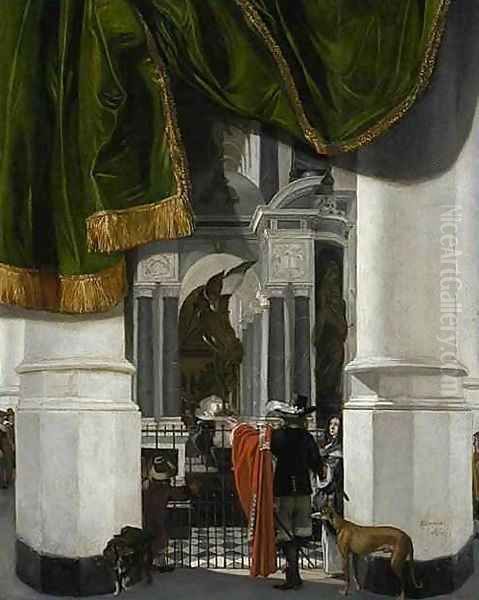
De Witte's color palette was generally subdued, dominated by earthy tones, grays, browns, and whites, which accurately reflected the often-austere interiors of Dutch Protestant churches following the Reformation. However, he used color with great subtlety, often introducing touches of warmer hues in the figures' clothing or in details like organ cases or stained-glass windows (though large expanses of colored glass were less common in Calvinist churches). These color accents provide visual interest and prevent the compositions from becoming monotonous.
Key Themes and Subjects
While best known for his church interiors, Emanuel de Witte's oeuvre encompassed a broader range of subjects, reflecting the diverse interests of the Dutch art market.
Church Interiors: Sacred Spaces and Civic Pride
The depiction of church interiors was a specialized genre that flourished in the Netherlands during the 17th century. After the Reformation, many Catholic churches were stripped of their elaborate decorations and converted for Protestant worship. These whitewashed, relatively unadorned spaces, with their emphasis on light and architectural form, became a popular subject for painters. De Witte’s church scenes often depict both the Oude Kerk and Nieuwe Kerk in Amsterdam and Delft. These paintings were not just religious statements; they also reflected civic pride in these important public buildings. His works often show sermons in progress, baptisms, or simply people walking and conversing, highlighting the church as a central space in community life. A notable example is his Interior of the Oude Kerk, Delft, with Pulpit and Tomb of Admiral Tromp (c. 1655-1660), which masterfully combines architectural grandeur with anecdotal detail. Another significant work is his depiction of the Portuguese Synagogue in Amsterdam, showcasing his ability to capture the unique atmosphere of different religious spaces.
Market Scenes: The Pulse of Daily Life
Beyond the sacred, De Witte also turned his attention to the vibrant secular life of Amsterdam, particularly its bustling markets. These paintings, such as The Fish Market (1672) or other general market scenes, are filled with a lively array of figures – merchants, shoppers, children, and animals – engaged in the everyday business of buying and selling. These works are characterized by their dynamic compositions, their rich anecdotal detail, and their depiction of a broad cross-section of society. They offer a fascinating glimpse into the commercial energy and democratic spirit of the Dutch Golden Age. In these scenes, De Witte’s skill in handling crowds and creating a sense of depth and activity is particularly evident. These genre scenes connect him to other painters of daily life like Jan Steen or Adriaen van Ostade, though De Witte’s focus was often on the broader public sphere.
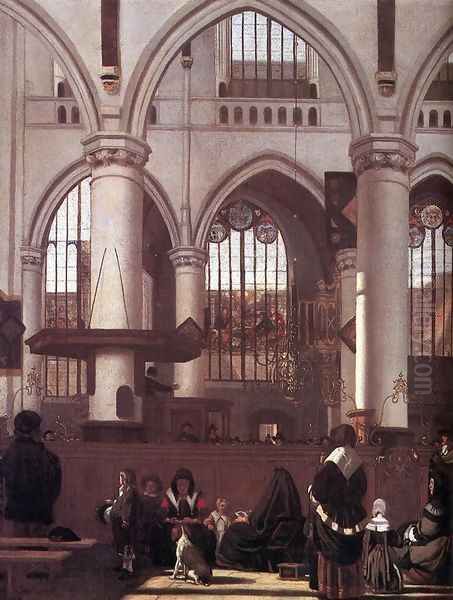
Figurative Elements and Narrative
The figures in De Witte's paintings, whether in churches or markets, are rarely mere staffage. They often contribute to a subtle narrative or enhance the painting's theme. A gravedigger in a church, a family gathered around a tomb, or animated interactions between buyers and sellers in a market add layers of meaning and human interest. His ability to integrate these figures seamlessly into their architectural or urban settings is a testament to his skill as a draftsman and storyteller. These figures often serve to guide the viewer's eye or to create focal points within the complex compositions.
Representative Works: A Closer Look
Several paintings stand out as quintessential examples of Emanuel de Witte's artistry.
Interior of the Oude Kerk, Delft (various versions, e.g., c. 1650-1651, Wallace Collection, London; c. 1660, National Gallery of Art, Washington D.C.)
De Witte painted the Oude Kerk in Delft multiple times, each version offering a unique perspective on its majestic Gothic architecture. These works typically feature the church's soaring white columns, ribbed vaults, and the prominent tomb of Admiral Maarten Tromp. Sunlight often streams through the clear glass windows, illuminating the vast space and highlighting the activities of the figures within – perhaps a sermon in progress, or visitors admiring the monuments. The interplay of light and shadow creates a sense of depth and volume, while the carefully placed figures give a sense of scale and human presence. The Washington version, for instance, is celebrated for its warm, golden light and the serene atmosphere it evokes.
Interior of the Portuguese Synagogue, Amsterdam (c. 1680, Rijksmuseum, Amsterdam)
This painting is a remarkable depiction of the Sephardic synagogue in Amsterdam, a testament to the city's religious tolerance. De Witte captures the grandeur of the building, with its massive columns and women's galleries. The scene is bathed in a soft, diffuse light, and numerous figures are shown engaged in worship or conversation. This work is significant not only for its artistic merit but also as a historical document of Jewish life in 17th-century Amsterdam. It demonstrates De Witte's versatility in portraying different types of religious architecture and their distinct atmospheres.
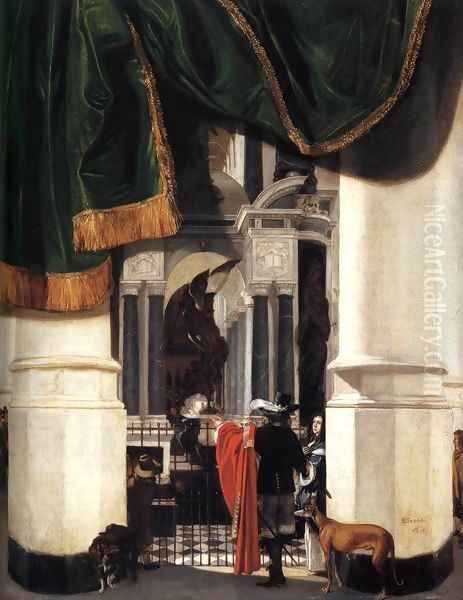
Market Scene at the Entrance to a Town (e.g., Vegetable Market, various versions)
De Witte’s market scenes are vibrant and full of life. He often depicted fish markets or general produce markets, set against an architectural backdrop that might include city gates or prominent buildings. These paintings are characterized by their lively crowds, detailed rendering of goods on display, and a sense of bustling activity. For example, his Fish Market (1672, formerly with art dealer Richard Green) showcases his ability to organize complex groups of figures and to capture the textures and colors of the market's offerings. These works reflect the prosperity of the Dutch Republic and the importance of trade in its daily life.
Adriana van Heusden and her Daughter at the Fishmarket in Amsterdam (c. 1662, National Gallery, London)
This painting is particularly interesting as it combines elements of a market scene with portraiture. It depicts the wife and daughter of a wealthy Amsterdam merchant, Joris de Wijs, who was also De Witte's landlord for a period. The figures are prominently placed amidst the lively activity of the fish market, creating a unique blend of genre and personal representation. The detailed rendering of the figures and their attire, set against the backdrop of the bustling market, provides a rich social commentary.
Relationships with Contemporaries
Emanuel de Witte was part of a rich artistic ecosystem, and his work was undoubtedly shaped by interactions with and awareness of his contemporaries.
In Delft, he would have been aware of the innovations of Carel Fabritius, known for his experiments with perspective and his tragic death in the Delft gunpowder explosion of 1654. The serene, light-filled interiors of Johannes Vermeer also originated in Delft during this period. Architectural painters like Gerard Houckgeest and Hendrick van Vliet (or Cornelis van Vliet) were direct predecessors and contemporaries in specializing in church interiors, particularly pioneering oblique perspectives that De Witte adopted and developed.
In Amsterdam, De Witte would have been in the orbit of Rembrandt van Rijn, whose mastery of chiaroscuro and psychological depth set a high bar for all Dutch artists. While their subject matter differed, a shared sensitivity to the expressive power of light is evident. Other Amsterdam painters included landscape artists like Jacob van Ruisdael, whose atmospheric scenes shared a certain romantic sensibility with De Witte's interiors, and genre painters like Jan Steen, whose lively depictions of everyday life offered a different perspective on Dutch society.
De Witte is known to have had direct interactions with some artists. For instance, records indicate that the genre painter Pieter de Hooch, also active in Delft and later Amsterdam, visited De Witte on several occasions between 1660 and 1663. Such interactions, common in the close-knit artistic communities of Dutch cities, would have facilitated the exchange of ideas and techniques.
The work of Pieter Jansz. Saenredam, who specialized in meticulously accurate and often starkly lit church interiors, provides an important point of comparison. Saenredam's approach was more architectural and objective, while De Witte's was more atmospheric and subjective, often imbuing his scenes with a greater sense of human warmth and sometimes a touch of melancholy. Other architectural painters of the era included Dirck van Delen, known for his imaginary palace courtyards and church interiors, and Anthonie de Lorme, who also painted church interiors, often with a strong emphasis on perspective.
Personal Life and Challenges
Despite his artistic achievements, Emanuel de Witte's personal life was fraught with difficulties and tragedy. He married twice. His first wife, Geertje Arents, died in 1642, shortly after their marriage. His second marriage, in 1652, to Lysbeth van der Plas, proved to be tumultuous. Lysbeth and their eldest daughter, then a young woman, were implicated in several instances of theft, including from their landlord, Joris de Wijs (whose wife and daughter De Witte painted). Lysbeth was eventually banished from Amsterdam for six years, and his daughter faced similar consequences. These events undoubtedly caused De Witte considerable distress and social embarrassment.
Financial problems plagued him throughout much of his life. Despite his talent, his works did not always find ready buyers, or perhaps he was a poor manager of his finances. He was known to be quarrelsome and had a reputation for a difficult temperament. Gambling debts further exacerbated his financial woes. At one point, he entered into a contract with the aforementioned Joris de Wijs, ceding all his future artistic production in exchange for lodging, food, and a small annual allowance, an arrangement that suggests dire financial straits. This contract was later torn up, but his financial instability persisted.
These personal and financial struggles likely contributed to a sense of bitterness and disillusionment in his later years. The contrast between the serene, ordered beauty of his paintings and the chaos of his personal life is striking.
Later Years and Tragic End
The latter part of Emanuel de Witte's life continued to be marked by hardship. His difficult personality, combined with his ongoing financial problems, likely isolated him. The art market in the Netherlands also experienced a downturn after the "Rampjaar" (Disaster Year) of 1672, when the country was invaded by France, England, and other powers, which would have further impacted his ability to earn a living.
The circumstances of his death are particularly tragic and speak to his despair. Around the winter of 1691-1692, at an advanced age (around 75), De Witte reportedly had an argument with his landlord. In a fit of despondency, he decided to end his life by hanging himself from a canal bridge. According to the account by the art historian Arnold Houbraken, the rope broke, and he fell into the canal. Because the canal froze over that night, his body was not discovered until several weeks later, in the spring of 1692. This grim end to a life of artistic brilliance underscores the profound personal suffering he endured.
Market Reception and Auction History
During his lifetime, Emanuel de Witte's market success was inconsistent. While his talent was recognized, his difficult personality and perhaps the specialized nature of his primary subject matter meant he did not achieve the consistent financial security of some of his contemporaries. His works were not always aligned with the prevailing tastes of the wealthiest patrons, who might have preferred more overtly ostentatious or classical subjects.
However, posthumously, his reputation grew, and his paintings became sought after by collectors. In the centuries since his death, his works have entered major museum collections worldwide. Auction records reflect a steady appreciation for his art. For instance, his Interior of the Oude Kerk, Amsterdam was sold at Christie's in December 1996 for a significant sum of $625,000. More recently, in 2005, the National Gallery of Art in Washington D.C. acquired a version of his Interior of the Oude Kerk, Delft, indicating the continued high regard for his work in the international art market.
The prices his paintings command at auction today reflect his status as one of an important master of the Dutch Golden Age. His unique blend of technical skill, atmospheric sensitivity, and ability to capture both the grandeur of architecture and the nuances of human presence within it ensures his enduring appeal to collectors and art lovers.
Legacy and Art Historical Evaluation
The art historical evaluation of Emanuel de Witte has evolved. Initially, he might have been seen primarily as a skilled practitioner within the established genre of architectural painting. However, over time, a deeper appreciation for his unique contributions has emerged. Modern scholarship recognizes him not just for his technical prowess in perspective and his mastery of light, but also for the emotional depth and psychological resonance of his work.
He is now widely regarded as one of the most innovative and expressive architectural painters of the 17th century. His ability to create a sense of atmosphere, to imbue his scenes with a palpable mood, and to integrate figures in a meaningful way sets him apart. His church interiors are more than just records of buildings; they are complex visual statements about space, light, faith, and community. His market scenes, too, are valued for their lively depiction of Dutch society and their contribution to the genre of everyday life.
Compared to Saenredam's cool precision, De Witte's work offers a warmer, more subjective, and often more dramatic vision. He took the established conventions of architectural painting and infused them with a new level of dynamism and emotional content. His influence can be seen in later painters who sought to capture the character and atmosphere of interior spaces.
Emanuel de Witte's legacy lies in his remarkable ability to transform stone and light into compelling visual poetry. His paintings invite viewers to step into the world of 17th-century Holland, to experience the solemn grandeur of its churches and the vibrant energy of its public spaces. Despite a life marked by personal hardship, his artistic vision remained clear and powerful, leaving behind a body of work that continues to captivate and inspire. He remains a key figure for understanding the richness and diversity of Dutch Golden Age painting, a master whose canvases reveal new subtleties with each viewing.